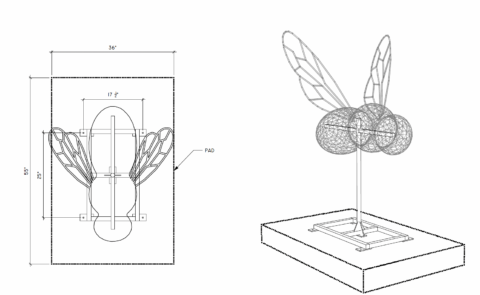We have everything you need for a CAD design to bring out your topiary artform inspiration. No project is too small or bib.
A 3D CAD design is a digital model created using Computer-Aided Design (CAD) software. It allows engineers, architects, and designers to build, modify, and visualize objects in three-dimensional space before they are physically manufactured or constructed. These designs are used in industries like automotive, aerospace, architecture, and product development.
Think of it like sculpting—only instead of clay, you’re shaping precise digital geometry. CAD software helps with measurements, materials, and even testing how parts will fit together.
A 3D CAD design for a topiary could help you visualize the shape, structure, and even the supporting framework before you start sculpting it in real life. You could design the wireframe that holds the plants, experiment with different animal or geometric shapes, and even plan how the greenery will grow over time.
For example, a horse-shaped topiary is an ambitious and elegant choice! You could design a majestic stallion rearing up or a peaceful grazing horse. With 3D CAD, you can map out the wireframe, define proportions, and even visualize how different types of plants will grow over the structure.
Would you like it to be life-sized or smaller? And do you envision a detailed structure with defined facial features or something more abstract?
Here’s how 3D CAD can help:
- Proportions & Scaling: You can design the wireframe with precise dimensions to match the size of a real horse.
- Structural Integrity: The CAD model can simulate how different materials might hold up over time.
- Plant Arrangement: Mapping out where different plants will go—whether it’s dense foliage for the body or trailing vines for a flowing mane.
An internal metal frame will give the topiary long-term durability, especially with a galloping pose where some parts may not be directly supported by the ground.
Here’s what to consider when incorporating the support frame:
- Material Selection: A sturdy metal, like stainless steel or galvanized steel, will resist rust and weathering.
- Anchor Points: The legs that touch the ground should have reinforced bases to handle the weight of the structure and the plants.
- Layering: The frame will need an outer layer of mesh or chicken wire to hold the greenery in place.
- Maintenance Access: Designing access points in the frame can help with shaping and trimming the plants as they grow.
Adding foliage:
That will make for a stunning piece! A hidden frame will create the illusion of a natural galloping horse, completely covered in lush greenery.
Since the metal frame is the backbone of your design, here’s a final set of things to consider:
- Weather Resistance: Make sure the frame is treated to withstand outdoor elements.
- Plant Growth Strategy: Choose plants that will grow thick and full to completely cover the structure.
- Maintenance & Trimming: Plan for how you’ll access different areas to prune and shape the greenery over time.
- Anchoring the Frame: Consider securing the legs into the ground with concrete footings for added stability.
This is going to be an incredible project! Would you like any guidance on selecting plants that will work best for your topiary?
For a life-sized galloping horse topiary, you’ll want plants that are dense, easy to shape, and can withstand regular trimming. Here are some of the best options:
- Boxwood (Buxus) – A classic choice for topiaries, boxwood has small, dense leaves that create a smooth, sculpted look.
- Privet (Ligustrum) – Fast-growing and easy to shape, privet is great for filling out large topiary structures.
- Yew (Taxus baccata) – A long-lasting evergreen with needle-like leaves that can be shaped into intricate designs.
- Holly (Ilex) – Holly offers a dense, lush appearance with spiny leaves that hold their shape well.
- Arborvitae (Thuja occidentalis) – A needled evergreen that works well for larger topiary designs.
- Japanese Holly (Ilex crenata) – Similar to boxwood but with a slightly different texture, great for detailed shapes.
These plants will help your horse topiary maintain its form while looking lush and vibrant year-round.
Here is an example CAD design that we do for most of our projects. They give you a live perspective of your topiary!


